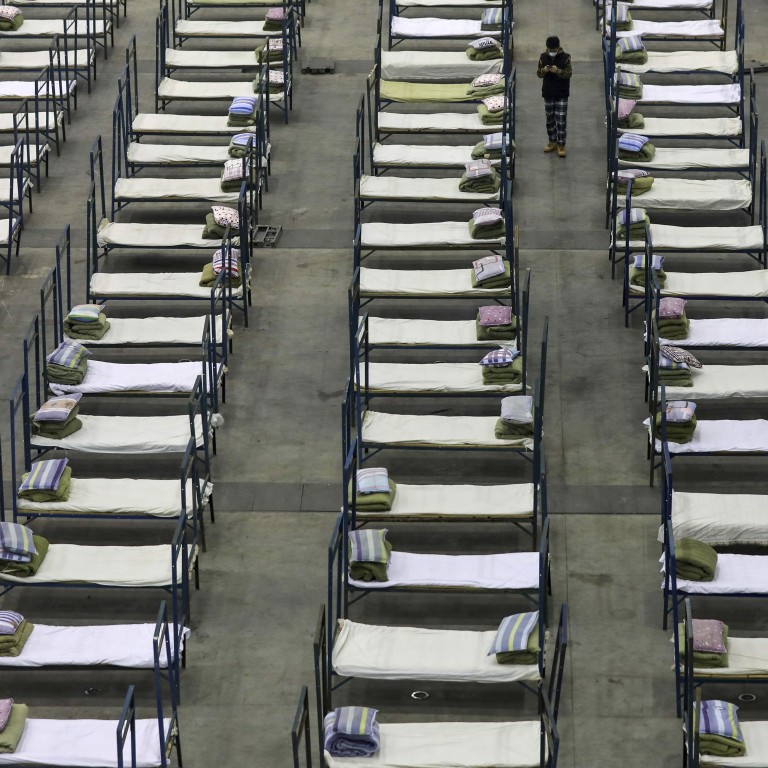
Is the worst over? Experts divided on coronavirus peak as new infections slow in Hubei epicentre
- Hubei health authority says new infection numbers have fallen 57 per cent in six days, but scientists caution that factors such as under-reporting could change this
- Epidemiologist says if containment has worked it will bring ‘dramatic reduction’ in new cases in mid-to-late February
New coronavirus infections in China outside the epicentre of Hubei province have fallen for seven days in a row, according to health authorities in the country, seemingly in line with predictions by some infectious disease specialists that the deadly outbreak may peak this month.
In Hubei excluding Wuhan city, where the outbreak began almost two months ago, the daily number of new infections fell for six consecutive days to 545 on Monday from 1,221 on Wednesday, according to provincial health authority figures. That is down 55 per cent.
“The new infection rate in all regions excluding Hubei province declined for seven consecutive days since February 3. Even if you include Hubei province and Wuhan, the national infection rate is declining,” said NHC official He Qinghua at a press conference on Tuesday morning.
While the pace of new infections seems to be slowing, China reported a nationwide total of 2,478 new cases and a record single-day high of 108 deaths on Monday. The previously unknown virus that brings on pneumonia-like symptoms has now killed 1,018 people in China and cumulative infections total 42,638.
Coronavirus: Heads roll in Hubei as Beijing axes health officials
Some researchers have created mathematical models to try to predict the course of the outbreak, which has been designated as an international emergency by the World Health Organisation.
One open-access data model published on Monday by scientists at Xian Jiaotong-Liverpool University in eastern Jiangsu province predicted a sharp decline in new confirmed infections next week and falling close to zero by February 23. However, the developers said other factors could affect the model.

“While this appears to be a relatively rapid near-end to new, confirmed cases, we must keep in mind that factors could change the trend or that the data on current cases could be under-reported, which would change the prediction,” said Yi Zhou, a lecturer at the university.
“If nothing else occurs that would change the trend, this model does suggest the worst is over for new infections.”
Another predictive mathematical model, published by researchers at the London School of Hygiene and Tropical Medicine on Friday, estimated that the outbreak would peak in mid-to-late February.
Epidemiology professor W. Ian Lipkin, director of the Centre for Infection and Immunity at Columbia University in New York, also said there should be “dramatic reductions” in mid-to-late February, if methods of containment have been effective.
Former WHO official says questions over coronavirus response can wait
“If we have an early spring, this should make a dramatic difference in the rate of acquisition of new infections. So the dates to think about are the end of February and whenever the temperature begins to climb,” said Lipkin at a news conference on Sunday.
However, some epidemiologists have disputed the accuracy of the official data from China, while reports in Chinese media such as Caixin have reported delays and inaccuracies in diagnosis methods, which suggested that the true number of infections may be higher.
“The data from China are so crude that it is impossible to get an accurate picture of what is going on,” said John Edmunds, an expert in infectious disease epidemiology at the London School of Hygiene and Tropical Medicine.
“It is very difficult to predict the timing of an epidemic peak, as it is highly sensitive to a range of factors, many of which are uncertain and are difficult to estimate,” said Jonathan Read, senior lecturer in biostatistics at Lancaster University.
“From 23 January onwards, a range of travel restrictions have been imposed within China. We don’t yet know the impact of these and because we don’t know how effective these are likely to be, any epidemic forecast is likely to be unreliable,” Read said.
Additional reporting by Kristin Huang

